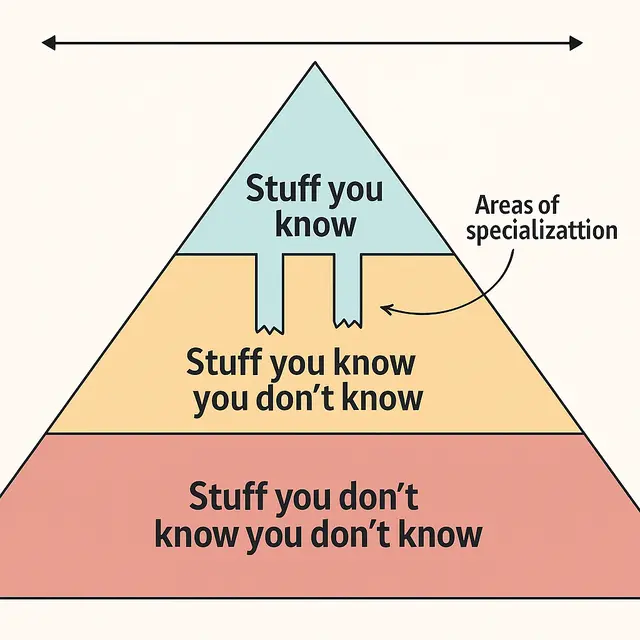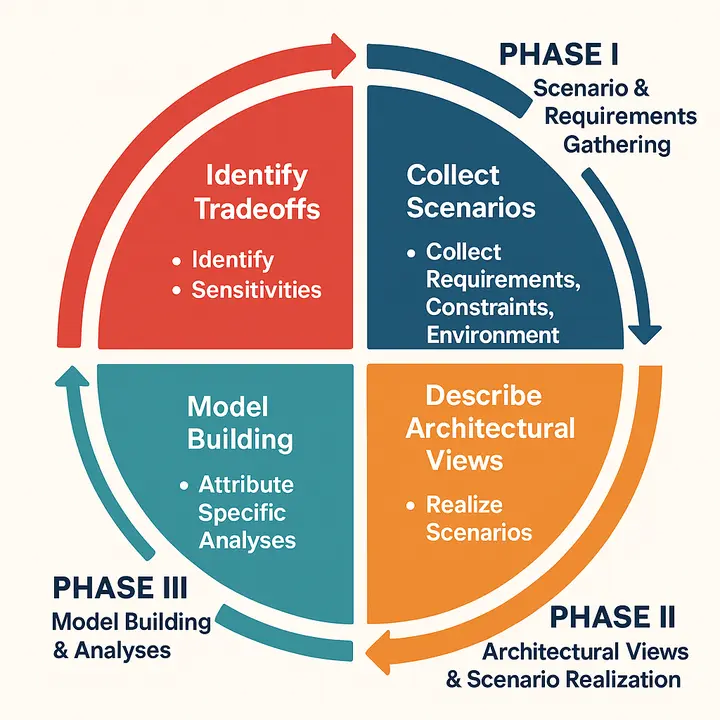A solution that excels on one front (say, performance) might falter on another (like security), so the best architecture is one that balances the trade-offs that matter most for a given situation.
There are no right or wrong answers in architecture — only trade-offs.
When someone says it depends, the natural follow-up question should be: On what?. In practice, it depends on a number of factors, often unique to your environment and goals. Context is king - not just in architecture. Factors such as the deployment environment, business drivers, company culture, budgets, timeframes, and the team’s skill set all influence which solution is optimal. An approach that fits a high-throughput trading system in a large enterprise may be overkill (or entirely wrong) for a scrappy startup building an MVP, and vice versa. Software architecture is hard precisely because everyone’s environment, situation, and problem is different. Architects must continuously analyze how well each option aligns with these contextual factors.
So what does an architectural answer depend on? Before we can answer that, it’s important to identify the key drivers and requirements that shape any design decision:
Key Drivers
The business goals and domain requirements are paramount. What does the software need to accomplish for the business to succeed? For example, a system for online banking will prioritize security and consistency, while a social media app might favor scalability and responsiveness. Architects must translate business goals into technical priorities, often expressed as architecture characteristics or quality attributes (the so called -ilities). For instance, a requirement for rapid market growth points to scalability and deployability; a regulated industry points to auditability and security, etc.
You cannot make a sound architectural decision without knowing which characteristics are the top priority for your stakeholders.
Quality Attributes, these so called, -ilities are the non-functional requirements like performance, reliability, maintainability, scalability, usability, etc. Standards such as ISO25010 define many of these quality characteristics (e.g. performance efficiency, compatibility, usability, reliability, security, maintainability, portability). Critically, quality attributes often conflict with each other. Many have opposing forces, a classic example is security vs. performance (tighter security checks can degrade performance, and vice versa). Similarly, flexibility can reduce simplicity; high availability can increase cost. The architect must identify which quality attributes matter most for the project’s success and be prepared to sacrifice or reduce priority on others. You cannot make a sound architectural decision without knowing which characteristics are the top priority for your stakeholders.
The operating environment imposes constraints. Are you deploying to cloud, on-premises, or an edge device? What are the regulatory or compliance constraints? How much legacy integration is needed? The deployment environment and existing ecosystem will affect options (e.g. certain tech stacks might be mandated, or perhaps cloud services can be leveraged). For example, an architecture for a highly distributed cloud system might leverage managed services and eventual consistency, whereas an on-prem solution might need to reinvent those capabilities or simplify the design.
Team Skills & Culture The people building and operating the system are an often underestimated factor. A design that looks great on paper can fail if the team cannot implement or maintain it. Company culture also plays a role, some organizations value move-fast-and-iterate, others prioritize rigorous upfront design; the architecture must align with how the team works. In short, the practicality of an architecture depends on the team’s capabilities and work style.
Time-to-market pressures or budget limitations can tilt decisions. A solution that is technically elegant but time-consuming to build might be wrong for a tight deadline. Sometimes a less “pure” architecture that’s faster to deliver is the right call, as long as it doesn’t paint you into a corner long-term. Architects must often decide between short-term wins and long-term flexibility, making conscious trade-offs if choosing a quick hack now means incurring technical debt (with a plan to address it later).
There are also external constraints, these include third-party integrations, vendor choices, or compliance requirements that are non-negotiable. If your system must interface with an external service that only communicates via a certain protocol, that will influence your design. Likewise, standards or compliance (like PCI, HIPAA, or ISO) can dictate certain architectural decisions (e.g. data encryption, audit logging, redundancy).
It’s about finding the acceptable compromise – rarely can you have it all.
it depends really means we need to weigh all these factors. We need to be vigilent and methodically evaluate how each option fares against the key criteria for the specific project. Let’s look at how this plays out with a couple of concrete examples, and then discuss techniques to analyze trade-offs systematically.
Analyzing Trade-offs Methodically
Answering architecture questions requires holistic analysis. When faced with a design decision, a good architect doesn’t jump to an answer based on personal preference or trendy tech, they perform a contextual trade-off analysis. Here are some practical guidance and techniques to do this effectively:
#1 Identify and Rank Quality Attributes First
Determine which architectural characteristics (quality attributes, or ilities) are most important for this project. Is it scalability? Time-to-market? Maintainability? Developer productivity? Prioritize them. In many cases, stakeholders can help rank thesek for instance, speed of feature delivery might be ranked higher than the ability to handle 10x load, or vice versa. You cannot evaluate options properly without a clear understanding of these priorities.
One useful exercise is to create an attribute utility tree where you break down and rank the scenarios related to each quality attribute. This makes the trade-offs explicit, you’ll see which attributes compete and which option favors which attribute. A practice from the Architecture Tradeoff Analysis Method, ATAM
Is it more important to handle twice our current traffic (scalability) or to cut our operational overhead in half?
We should enumerate viable options (including the do-nothing or status quo option). For each, consider the pros and cons relative to the prioritized criteria. It helps to involve different perspectives: development leads, ops engineers, business stakeholders. After listing pros/cons, discuss and even debate them. You’ll often find each option has an advocate citing different concerns. Encourage the team to voice what success metrics they care about. This brainstorming ensures you capture trade-offs you might not see alone.
Ask “What if…?” and “What’s most important?”
The key role of the architect is to frame the choice in terms of business impact, so the right people can weigh in
When stuck between options, ask questions that force explicit trade-off decisions: “Would we rather have X or Y?” For example, *Is it more important to handle twice our current traffic (scalability) or to cut our operational overhead in half? By posing such questions to stakeholders (especially business owners), you translate technical trade-offs into business decisions. This is a key role of the architect, to frame the choice in terms of business impact, so the right people can weigh in. Often, you’ll find that one of the competing qualities clearly matters more for business success, and that will guide the decision. It’s about finding the acceptable compromise, rarely can you have it all.
Use Decision Matrices or Tables
To systematically compare options, it can help to create a simple decision matrix. List your key criteria (the must-have quality attributes, plus other drivers like cost or team familiarity) and score each architecture option against them (e.g. High/Medium/Low or a numeric scale). This visual aid makes the trade-offs explicit – you might see Option A scores high on performance and low on flexibility, whereas Option B is the opposite, etc. It’s not about producing an automatic “score” to pick a winner, but about making sure you’ve thought through each dimension. For example, a decision table might reveal that Microservices win on scalability and team autonomy, while Monolith wins on simplicity and speed of development – then you consciously decide which aligns better with your project’s priorities. Such tables also serve as great communication tools to get everyone on the same page regarding trade-offs.
The software architecture community has developed methodologies for trade-off analysis. One is ATAM (Architecture Tradeoff Analysis Method), created by SEI at CMU, which provides a structured approach to evaluate architecture against quality attribute goals. Using ATAM involves stakeholder workshops to surface scenarios and then analyzing each architecture approach for how well it satisfies those scenarios, identifying sensitivity points, trade-offs, and risks. Even if you don’t run a full ATAM exercise, adopting its principle of systematically examining how each design addresses (or hampers) each quality attribute is valuable.
Another lightweight tool is Architectural Decision Records (ADR) – whenever you make a significant decision, write an ADR that records the context, the options considered, the decision, and the reasoning (including what trade-offs were accepted). This not only forces you to articulate the rationale (which improves the decision process), but also creates documentation for future maintainers about why things are the way they are. It’s far better than a C4 diagram alone, which might show what you built but not why.
Stay Educated on Patterns and Practices
A breadth of knowledge helps you see more options and trade-offs. Architects need a broad toolkit, familiarity with a wide array of technologies and patterns, to see possibilities others might miss. Continuous learning builds your intuition about what works where. For example, knowing multiple integration patterns (synchronous REST vs. messaging vs. event sourcing) allows you to choose one aligned with your needs rather than defaulting to whatever you used last time. Keep an eye on industry-proven reference architectures and their documented pros/cons; learn from case studies (like Netflix’s famous migration to microservices, or others who backtracked to monoliths). This helps ground your it depends in real evidence.

Beware of Dogma and Simplistic Answers
Perhaps the most important practical guidance is a mindset one: avoid absolute always/never rules and be wary of anyone selling a one-size-fits-all solution. The reality is, what was right for one company could be wrong for yours. Great architects remain curious and skeptical; they probe does this apply here, and why or why not?
Remember that architecture is the stuff you can’t Google, meaning, you won’t find definitive answers cut-and-pasted on StackOverflow because your situation has unique nuances. Instead of seeking certainty in generic best practices, focus on understanding the trade-offs deeply for your case.
As Neal Ford humorously notes, architects often appear grumpy because we don’t live in a binary world of simple choices – we must constantly navigate the gray areas and make judgment calls. Embrace that reality.
In the end, architecture is about embracing ambiguity. Rather than chasing a premature certainty or the “perfect” design, seasoned architects accept that it depends is not a cop-out but a starting point for critical thinking. By systematically examining context and trade-offs, we aim to make the least worst decision – a term sometimes used to acknowledge that every choice has downsides, but one option will likely be the most acceptable compromise given the goals. We then document our reasoning, remain open to feedback, and adapt as conditions change.
Keep asking depends on what?, keep learning, and you’ll continue to grow.
